This spring, the UN released a scientific report that shows a million species are at risk of extinction, many within decades. The Government of Canada committed to doubling the amount of protected nature across lands and oceans, in an effort to protect the habitats vital to the survival of important Canadian species.
On September 4, 2019, the Minister of Environment and Climate Change, Catherine McKenna, announced that the federal government had invested up to $7.6 million this year in 52 projects across the country. Canada is working closely with provinces and territories, Indigenous Peoples and other partners on a new approach to species conservation.
One of the projects targets the Georgian Bay Biosphere region that was successfully a ‘Community-Nominated Priority Place.’ The four-year project will benefit 46 listed species at risk, including the Blanding’s Turtle and the Massasauga Rattlesnake, as well as six COSEWIC-assessed species not yet listed. The project will cover 347,000 hectares of eastern Georgian Bay coast and inland areas, and was granted $1,954,879.

The Georgian Bay Biosphere and co-applicants Shawanaga First Nation, Magnetawan First Nation and Georgian Bay Land Trust, will work with partners to gather data, and plan and implement actions to address threats, such as roads and railroads, invasive plants and climate change.
“Areas with high biodiversity habitat will benefit from strategic and collaborative protection efforts that come from combining traditional science and Indigenous knowledge” says Adam Good, Shawanaga First Nation Band Manager.
“With this biodiversity protection project, we will accelerate our collective capacity to address threats to Species at Risk, with better planning and policy tools, science-based management, and strategies to reduce the threats to these species,” says Greg Mason, general manager of the Georgian Bay Biosphere. “Each partner brings critical information and expertise that when combined will provide a much more powerful knowledge base to identify priority species’ habitats and supporting conservation measures.”
Bill Lougheed, executive director of the Georgian Bay Land Trust agrees: “New and existing information about species’ populations and enhanced mapping tools will inform land use and coastal management models. Reptiles and amphibians at risk of road mortality will be better understood and managed. A variety of bat species will benefit from university research partnerships, as well as birds detected by radio telemetry”.
Cory Kozmik, Environmental Management Biologist for Magnetawan First Nation says: “we are very excited to be part of this collaborative initiative that integrates Traditional Knowledge, research, stewardship and conservation across a diverse network of partners. “Over four years, our project will result in more effective landscape governance for priority species in the Georgian Bay Biosphere region,” says Kozmik. “It will protect ecosystem services, and will help to mitigate the impacts of climate change, while creating jobs in the conservation sector.”
The Township of the Archipelago was a significant financial partner. Reeve Bert Liverance says: “This project will go a long way to help the township realize our vision to ensure the continued guardianship of the health and wellbeing of the Georgian Bay shoreline and its watershed areas.” Other key partners include: Wasauksing First Nation, Carling Township, the West Parry Sound Geography Network, Killbear Provincial Park, Friends of Killbear Park, and Bird Studies Canada.
Quick facts
- Through Budget 2018, the Government announced $1.35 billion for the Nature Legacy initiative. This amount represents the largest investment in nature conservation in Canadian history.
- In June 2018, federal, provincial, and territorial ministers responsible for parks, protected areas, conservation, wildlife, and biodiversity agreed to a new set of principles to guide collaborative work on species at risk.
- Through the Canada Nature Fund, up to $200 million will be available over five years for various funding initiatives to help with the protection and recovery of species at risk.
- Of the 52 new projects, 15 projects are for community-nominated priority places for species at risk in key areas across Canada. These areas were selected through an open call for applications across Canada under the new Canada Nature Fund.
- A total of 37 projects are in partnership with provinces and territories in 11 priority places: southwest Nova Scotia, Saint John River Valley, Prince Edward Island forested landscapes, Saint Lawrence Lowlands, Ontario’s Long Point Walsingham Forest, Manitoba mixed-grass prairie, Saskatchewan south of the divide, Alberta’s Saskatchewan River watershed, dry interior of British Columbia, southwest British Columbia, and Yukon’s south Beringia.
- Since 2015, the Government of Canada has been working toward doubling the amount of protected nature across our lands and oceans, ensuring we protect the habitats vital to the survival of iconic Canadians species.